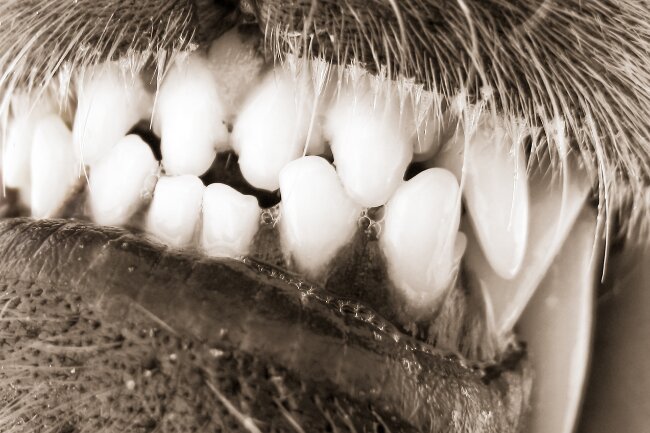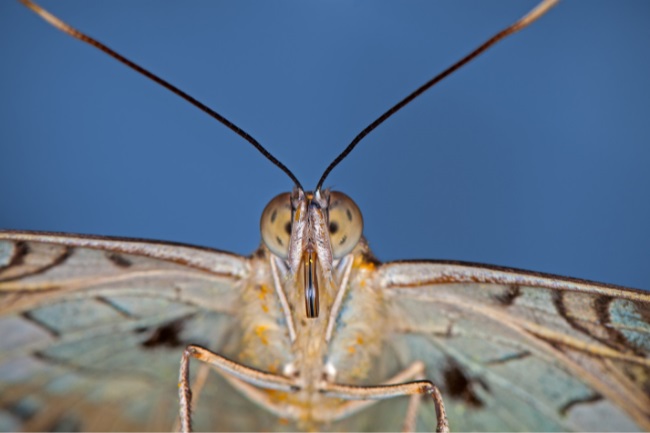Butterflies do not have teeth as they feed only on liquid food. Instead, they have a proboscis, through which they suck up their dinner.
Contents
What are teeth?

Teeth are incredibly diverse across the animal kingdom. From the blade-like teeth of many fish to the wide molars used by grazing animals, they come in all shapes and forms.
The technical definition of teeth is that they are calcified structures used to break down food, however, their structure is much more complex than it first appears.
Teeth are composed of a different material to the bone and have several layers within them. Within a human mouth, different teeth have different purposes. The canines, the pointed teeth towards the corner of our mouths, are used to grip and tear into the meat, while the wide molars are more to grind down food.
Many rodent species are well known for their constantly growing incisor teeth, those stereotypical rabbit-like teeth at the front of their mouths. Due to the tough diets these animals feed on, often including grasses and nuts, it is an advantage for their teeth to keep growing, as they are so quickly worn down.
While the teeth of mammals have roots that hold them in place within the jaw bone, some animals have teeth that are a part of the bone itself. This is particularly common among some species of fish.
Also read: Do Ants Bite or Sting? Do They Have Teeth? (FAQ)
How do animals use teeth?
Teeth are amazingly multipurpose in the natural world. They have a number of functions.
Eating
Eating is the most obvious use for teeth, and it is a vital one. In the wild damage to teeth or tooth decay can result in a slow painful death from starvation.
Even within humans, tooth-related health issues have long plagued mankind. Today much of the world is blessed with the wonders of dentistry.
Also read: What Does a Dragonfly Eat and Drink? (Habits Explained)
Defence
Teeth aren’t just for hunting, they can be for defending yourself against harm. This may seem more obvious in animals such as warthogs that have large tusks they can use to ward off an attack by larger predators.
Intimidation
Just as a movie character may flash their gun or flick a knife blade to intimidate the enemy, animals may show their teeth too to intimidate their enemies. This may be during the contest for a mate for example.
Hunting
For expert hunters like lions, teeth are vital for bringing down their prey, helping to grip and tear through the flesh.
Other animals, such as snakes use their teeth differently, utilising them to deliver a dose of venom that helps to paralyze or kill their prey.
Communication
We may not realise it but we use our teeth to communicate in more ways than just helping us to enunciate. Showing our teeth can be a sign of happiness, a smile with and without them on display often meaning slightly different things.
In animals, baring teeth can often be an aggressive move. A dog or monkey that shows its teeth is often giving the first warning signs prior to more extreme body language.
Also read: How do Ants Communicate? (Different Ways & Situations)
Do butterflies have teeth?

Butterflies do not have teeth. This is large because they do not need them, their main food being entering liquid; nectar.
However, in general, insects do not possess teeth, instead they have an array of different mouthparts, such as mandible to bite and chew, or stylets to suck up liquids like sap.
Butterflies in fact have a proboscis, a long straw-like appendage that they keep rolled up under their head the majority of the time.
When the time comes for them to feed they unfurl this feeding tube and take in whatever liquids they require.
| Butterfly Species | Mouthpart Structure |
|---|---|
| Monarch Butterfly | Monarchs have a long, tubular proboscis for nectar feeding |
| Painted Lady Butterfly | Painted Ladies have a coiled proboscis for nectar feeding |
| Swallowtail Butterfly | Swallowtails possess a long proboscis for nectar extraction |
| Blue Morpho Butterfly | Blue Morphos have a short, spongy proboscis for fruit feeding |
| Cabbage White Butterfly | Cabbage Whites have chewing mouthparts for leaf consumption |
So what do butterflies use instead for the other tasks that teeth provide in other animals?
Eating
As stated the proboscis is perfectly adapted to slurp up the butterflies food.
Defence
The only form of defence most butterflies have is poison. However, unlike the snake they don’t inject it with their teeth, instead, it is within their bodies and their enemies have to eat them for it to affect them.
Also read: Can Butterflies Sting? How do They Protect Themselves?
Intimidation
Butterflies actually use their wings and their movements to intimidate. Using colours to let their enemies know that they are toxic. Some species also produce sounds to scare those that mean them harm.
Hunting
Butterflies are largely herbivores. Aside from finding flowers they do not need to hunt.
Communication
As with intimidation butterflies will use the colours of their wings to communicate. They will also use pheromones to inform the opposite sex of their presence. Beyond this they also use body language through the flapping of their wings, or occasionally the movement of their antennae.
Who needs teeth?
Teeth are a great thing for many species, providing them with a range of useful services. For the little butterflies of this world though teeth appear to have no useful function. From eating to communicating they have their skills invested in other more useful appendages and bodyparts.

